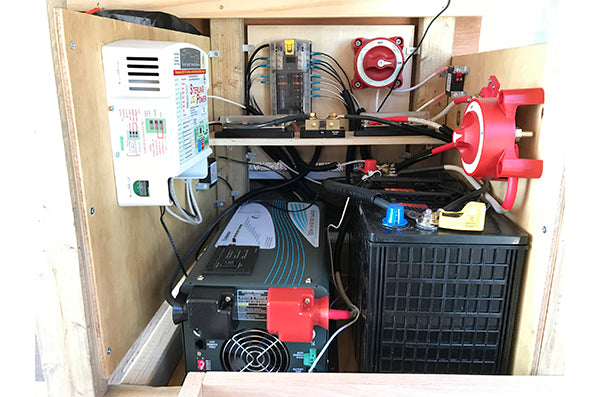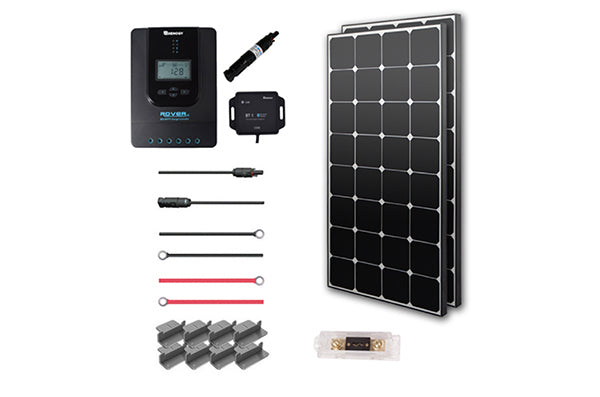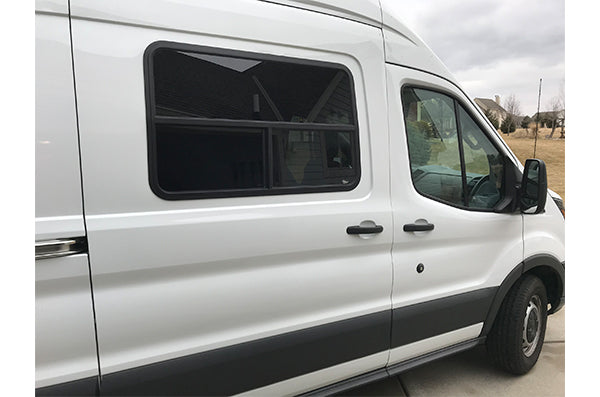Before we begin, I must disclose that this was our first major electrical project and a certified electrician should be consulted before any installation work is started.
Like many other projects in our van conversion process, the design phase of the electrical system was far more time consuming than the actual installation. Our design took a few months of consistent research and iteration based on new findings and feedback while the install took around 24 hours.
Objective: Develop an electrical system that utilizes charging options from shore power (plugged into 120v AC), as well as the van's alternator while driving. Solar may be added later, but is not part of the initial design. Also, we needed enough battery capacity for a weekend off the grid, void of any charging sources.
Clutch Resources:
Far Out Ride - Electrical designFord Transit USA Forum
Blue Sea wire size chart
Tools & Hardware
Hydraulic wire crimper (for terminals 8ga and below) - amazon.comRatchet wire crimper (for terminals 10ga and above) - amazon.com
Digital clamp meter - amazon.com
Wire stripper - amazon.com
Heat gun - amazon.com
Razor blade
Heat shrink ring terminals (assorted sizes) - amazon.com
Heat shrink butt connectors (assorted size) - amazon.com
Identifying Power Consumption
The design phase began by identifying the loads we were looking to power and understanding their maximum daily power consumption based on our projected usage. Power consumption is measured in Amp Hours (AH) which is defined as the amount of energy charge in a battery that will allow one amp of current to flow for one hour. This math will allow us to properly size our battery bank to fit our needs.
| Loads | Power Consumption (AH) |
| Interior main cabin lights (8 puck LEDs) | 1.5 AH Instant / 4 AH Daily |
| Garage lights ( 2 LED bars) | 0.5 AH Instant / 1 AH Daily |
| Maxxair fan | 4.5 AH Instant / 12 AH Daily (summer) |
| Device charging (3 USB outlets) | 1 AH Instant / 4 AH Daily |
| Webasto furnace | 2.5 AH Instant / 20 AH Daily (winter) |
| Rear fan | 0.5 AH Instant / 3 AH Daily |
| Total | 10.5 AH Instant / 44 AH Daily |
We've determined that our absolute maximum daily power consumption will be 44 amp hours, but this a little high based on the fact that the Webasto furnace and Maxxair fan will not be both running at full capacity across all seasons. Taking this into account, we're going to use 35 AH as our max daily power consumption number.
Choosing Battery Size & Type - Vmax 155AH AGM Battery
Using 35 AH as our daily consumption, we began to explore our options for both battery size and type. For the type of battery, we wanted something that was going to be low maintenance, last for years and not crush the bank account. We landed on an AGM deep cycle battery. AGM batteries are spill proof, stand up to low temperatures, charge up to 5x faster than other battery types, are vibration proof and are designed to be occasionally deep cycled (deeply discharged using most of its capacity). When sizing a battery, it's important to remember that even though you can deep cycle the battery, it is not something you want to do regularly. To prolong the life of the battery, you want to avoid discharging to less than 50%. We selected a 155 AH battery, which will allow us 2 days of full usage void of charging, while not discharging the battery below 50%. There are many manufacturers of our desired battery size and type, but we selected Vmax as they are made in the USA, have great reviews, provided great customer service when we had questions and offer 10% off your first order + free shipping!
Electrical System Design

Our electrical system design can be broken up into 3 main sections: shore power input, van alternator power input and van load output. Although the design looks large, almost the entire system is housed in roughly a 14" x 18" section of the van underneath the bed. We would highly recommend having at least 3 walls and a shelf in your electrical cabinet for proper placement of all the components.
Our entire system is grounded at one point to the van chassis. The point we chose was the emergency brake metal housing, which is considered an approved grounding point in the 2015 Ford Transit BEMM guide. The grounding points can be found on page 126 of the guide.
The shore power input section of the system allows us to plug 120 volt AC power (same voltage as your house) into the van and run that power through an inverter / charger unit. The inverter / charger allows for charging of our 155 AH house battery or and offers 2 GFCI outlets for AC power inverted from our house battery. After significant research we decided on the Renogy 1000 watt inverter charger. Our main use for this device is the charging function, which offers a 4 stage smart battery charger. The Renogy is also a pure sine wave inverter which produces much cleaner power than a modified sine wave unit and can be used to charge sensitive electronics like a laptop. Priced at $399, the Renogy is in the middle of the pack, but more than satisfies our needs for this van conversion.
The van alternator power section allows the 155 AH house battery to be charged while the vehicle is moving by taking power from the alternator and running it through a battery to battery charger. Ford has designed Customer Connection Points (CCP) to allow vehicle owners to better access power. These connection points are located on the bottom left side of the drivers seat. Depending on your van's model / options, you will either have 1 or 3 connection points. Each point is equipped with a 60 amp fuse which is located under the driver's seat. Accessing this fuse required removal of the driver's seat, batteries, etc which is why we highly recommend installing a breaker between the CCP and any load. If you only have one CCP and require more than 60 amps, check out the Morey's in Transit blog post. Our CCP connection is only being used to power our battery to battery charger which requires 30 amps, so one connection point is sufficient. There seem to be two main options to consider when looking to charge your house battery from the alternator. These include either a battery to battery charger (smart charger) or an automatic charging relay (ACR). Both options isolate the house battery from the vehicle when the vehicle is not running, but the battery to battery charger offers multi stage charging and regulates power output which can have a big impact on extending the life of your battery. We chose the Sterling BB1230 battery to battery charger for our design. This device had very positive reviews and was recommended by several members on the Ford Transit Forum. The Sterling is very simple to use and offers many different charging profiles to suit almost any need.
The individual loads e.g., fan, lights, etc, are powered by the house battery through a Blue Sea Blade fuse box. This approach allows all positive and negatives from the loads to come back to one central location along with the ability to fuse each load independently.
The overall system was designed with several safeguards in the way of breakers / switches to protect or isolate a portion of the system, if needed. The 50 amp breaker between the CCP and battery to battery charger allows for the stoppage of power from the alternator while also protecting the 60 amp CCP fuse. The on/off switch between the house battery and positive buss can disconnect the house battery from the entire system. The last on/off switch, between the fuse box and positive buss allows for a quick disconnect of all van loads. We purchased blue sea branded breakers and switches based on durability and reviews.
We know how daunting the design and install of the electrical system can feel and we hope this has helped to answer some of your questions. Please reach out with any questions and we will do our best to answer or direct you to help.




13 comments
Cary Gilbert
Does anyone KNOW the load rating and specs of the CCP on a 2021 Transit with dual batteries? I find a lot of “I Think” or “I assume” but no facts on any sites
Does anyone KNOW the load rating and specs of the CCP on a 2021 Transit with dual batteries? I find a lot of “I Think” or “I assume” but no facts on any sites
Larry McMahon
Janusz,
Thanks for reaching out! In order to determine the size of the inverter, you’ll need to find some specifics on the consumption for all devices you plan to use. I added a link to a good blog that walks through how to identify the right inverter size. As far as the warranty goes, Ford provided the Customer Connection Points (CCP) to enable customers to utilize things like power inverters. The CCP’s have a fuse and I would highly suggest placing a fuse between the CCP’s and the inverter. I know you mentioned the dealer wasn’t much help, but I would triple check on any warranty specifics with them just to be 100% sure as things can always change year to year.
https://theinverterstore.com/portfolio-items/what-size-of-inverter-do-i-need/
Thanks
Larry
Janusz,
Thanks for reaching out! In order to determine the size of the inverter, you’ll need to find some specifics on the consumption for all devices you plan to use. I added a link to a good blog that walks through how to identify the right inverter size. As far as the warranty goes, Ford provided the Customer Connection Points (CCP) to enable customers to utilize things like power inverters. The CCP’s have a fuse and I would highly suggest placing a fuse between the CCP’s and the inverter. I know you mentioned the dealer wasn’t much help, but I would triple check on any warranty specifics with them just to be 100% sure as things can always change year to year.
https://theinverterstore.com/portfolio-items/what-size-of-inverter-do-i-need/
Thanks
Larry
JANUSZ JAROSZWSKI
BECAUSE OF MY WIFES DISABILITY SHE SLEEPS IN A POWER LIFT CHAIR.I WANT TO INSTALL ONE IN MY 2019 TRANSIT .120 VOLT.WILL AN 1000 WATT PURE SINE INVERTER BE ENOUGH TO ALSO POWER COFFE POT?WILL THIS VOIDMY WARRENTY?CAN AN INVERTER DAMAGE TRUCKS ELECT SYSTEM? FORD DEALER IS NO HELP.TRANSIT IS 350 PASSENGER VAN.THANK YOU JANUSZ
7
BECAUSE OF MY WIFES DISABILITY SHE SLEEPS IN A POWER LIFT CHAIR.I WANT TO INSTALL ONE IN MY 2019 TRANSIT .120 VOLT.WILL AN 1000 WATT PURE SINE INVERTER BE ENOUGH TO ALSO POWER COFFE POT?WILL THIS VOIDMY WARRENTY?CAN AN INVERTER DAMAGE TRUCKS ELECT SYSTEM? FORD DEALER IS NO HELP.TRANSIT IS 350 PASSENGER VAN.THANK YOU JANUSZ
7
Larry
Craig,
Thanks for reaching out! It’s been a while now since we did this install and unfortunately I did not document exactly why we chose the BB1230 vs the BB1260. If my memory serves me right, we decided the 60 amp was a bit overkill to charge our 155 amp hour AGM battery. Also, we were running the B2B charger from a singular 60amp CCP point. We are currently using a cooler vs fridge, so most of our electrical consumption is from fans or charging electronics. We are finding that the majority of the time, our 2x 100 watt solar panels keep us above 90% charged, so the BB1230 is more than adequate for our needs. Best of luck on the build!
Craig,
Thanks for reaching out! It’s been a while now since we did this install and unfortunately I did not document exactly why we chose the BB1230 vs the BB1260. If my memory serves me right, we decided the 60 amp was a bit overkill to charge our 155 amp hour AGM battery. Also, we were running the B2B charger from a singular 60amp CCP point. We are currently using a cooler vs fridge, so most of our electrical consumption is from fans or charging electronics. We are finding that the majority of the time, our 2x 100 watt solar panels keep us above 90% charged, so the BB1230 is more than adequate for our needs. Best of luck on the build!
Craig
We’re looking to mimic your electrical design so this is very helpful. Our power audit is even very similar. Why did you opt for the 30amp B2B charger rather than the 60amp model?
Thanks!
We’re looking to mimic your electrical design so this is very helpful. Our power audit is even very similar. Why did you opt for the 30amp B2B charger rather than the 60amp model?
Thanks!
Larry
Lewis,
Thanks for the comment. We sized all of our wiring based on the amps and length of the wire. Based on our calculations, 4ga was enough to support that part of our system. There is some great documentation online regarding selecting the appropriate wire size. Here is an example, but there is a ton more like this. (https://www.thespruce.com/matching-wire-size-to-circuit-amperage-1152865). I hope this helps!
Thanks
Larry
Lewis,
Thanks for the comment. We sized all of our wiring based on the amps and length of the wire. Based on our calculations, 4ga was enough to support that part of our system. There is some great documentation online regarding selecting the appropriate wire size. Here is an example, but there is a ton more like this. (https://www.thespruce.com/matching-wire-size-to-circuit-amperage-1152865). I hope this helps!
Thanks
Larry
Lewis
Hi there …. Nice wiring diagram and a clean I stall job good work. I almost have the same equipment, just 220ah total. I have the same renogy 1000w I better charger and wasn’t super on wiring size from battery to battery and then out to bus bar. I noticed you done 4awg wire is that large enough??? Thanks lewis
Hi there …. Nice wiring diagram and a clean I stall job good work. I almost have the same equipment, just 220ah total. I have the same renogy 1000w I better charger and wasn’t super on wiring size from battery to battery and then out to bus bar. I noticed you done 4awg wire is that large enough??? Thanks lewis
Larry
Kurtis,
Unfortunately i’m not sure exactly the best way to achieve the 240A in that case. I would suggest posting the question on the Ford Transit Forum (link below) as I have had great luck using that channel when I can’t seem to find answers elsewhere. Best of luck!
(https://www.fordtransitusaforum.com/)
Larry
Kurtis,
Unfortunately i’m not sure exactly the best way to achieve the 240A in that case. I would suggest posting the question on the Ford Transit Forum (link below) as I have had great luck using that channel when I can’t seem to find answers elsewhere. Best of luck!
(https://www.fordtransitusaforum.com/)
Larry
Kurtis Sloan
The diagram is very helpful. Like Matt I like simple, don’t need shore power , and am looking at an isolator instead of b2b charger. 2019 transit comes with 1 ccp @ 60A and 1 @ 175A. If you need 240A there is another way to do that as well , the 2 CCP cannot be combined as in earlier models.
The diagram is very helpful. Like Matt I like simple, don’t need shore power , and am looking at an isolator instead of b2b charger. 2019 transit comes with 1 ccp @ 60A and 1 @ 175A. If you need 240A there is another way to do that as well , the 2 CCP cannot be combined as in earlier models.
Larry McMahon
Vanda,
We mounted the 50 amp breaker to the lower back side of the drivers seat, close to the CCP. To do this, we used construction adhesive to secure a 3/4" piece of plywood slightly larger than the breaker and screwed the breaker to the plywood. Keeping the breaker close to the CCP also limited the amount of 6 gauge wire we had to run. Hope this helps!
Larry
Vanda,
We mounted the 50 amp breaker to the lower back side of the drivers seat, close to the CCP. To do this, we used construction adhesive to secure a 3/4" piece of plywood slightly larger than the breaker and screwed the breaker to the plywood. Keeping the breaker close to the CCP also limited the amount of 6 gauge wire we had to run. Hope this helps!
Larry
Vanda
Good morning – how did you mount the 50A breakers? Do you have to use an enclosure or can you surface mount to your electrical box? I think they are surface mounted but the pic is small and my eyes don’t work very well… :-/
Thank you!!
Good morning – how did you mount the 50A breakers? Do you have to use an enclosure or can you surface mount to your electrical box? I think they are surface mounted but the pic is small and my eyes don’t work very well… :-/
Thank you!!
Larry McMahon (Admin)
Matt,
The single 60 amp CCP is more than enough to charge your 150 amp hour house battery. We used a Vmax house battery that has a recommended charging current of 10amps-35amps. We opted to use the sterling b2b charger to optimize the charging current from the van to the battery rather than using an isolater. This option will extend the life of the battery. The most common reason to combine the 3 CCP’s is to increase amp’s for the use of a larger power inverter. Using only the single CCP you only get 720 watts vs combining all 3 you can pull 2160. watts. I hope this is helpful!
Matt,
The single 60 amp CCP is more than enough to charge your 150 amp hour house battery. We used a Vmax house battery that has a recommended charging current of 10amps-35amps. We opted to use the sterling b2b charger to optimize the charging current from the van to the battery rather than using an isolater. This option will extend the life of the battery. The most common reason to combine the 3 CCP’s is to increase amp’s for the use of a larger power inverter. Using only the single CCP you only get 720 watts vs combining all 3 you can pull 2160. watts. I hope this is helpful!
Matt
Thanks for the diagram. I have a 2018 transit that when it comes to the electrical system, I’m trying to go as basic as possible just like my last van but I’m finding way more options than I thought were available.
I’m posting a comment to ask about the 60amp ccp you connected to. I am wondering if that connection point alone would be enough to charge a 150 amp-hour house battery via an isolator, because I am not sure I wanted to have shore power like you do. I understand that some vans have 3 ccp’s and they can be combined for a total of 180 amps but I’m not sure it’s necessary. I’m hoping that a single CCP would be capable of charging a single house battery.
Thanks for the diagram. I have a 2018 transit that when it comes to the electrical system, I’m trying to go as basic as possible just like my last van but I’m finding way more options than I thought were available.
I’m posting a comment to ask about the 60amp ccp you connected to. I am wondering if that connection point alone would be enough to charge a 150 amp-hour house battery via an isolator, because I am not sure I wanted to have shore power like you do. I understand that some vans have 3 ccp’s and they can be combined for a total of 180 amps but I’m not sure it’s necessary. I’m hoping that a single CCP would be capable of charging a single house battery.